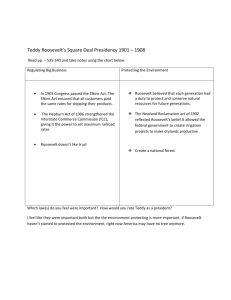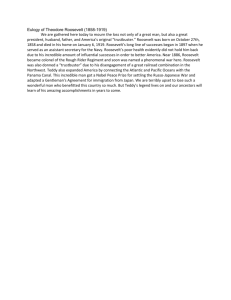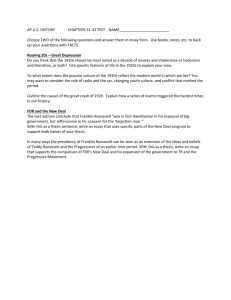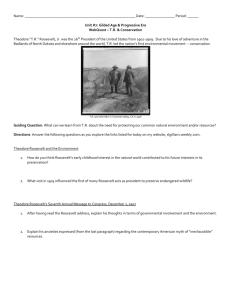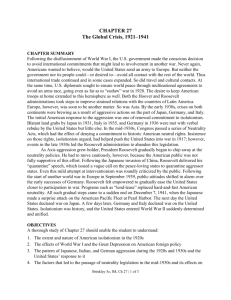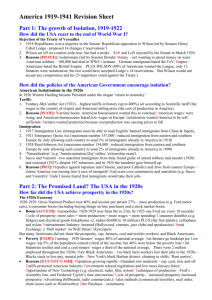Match the term on the left with its definition on the right: W Bank
advertisement
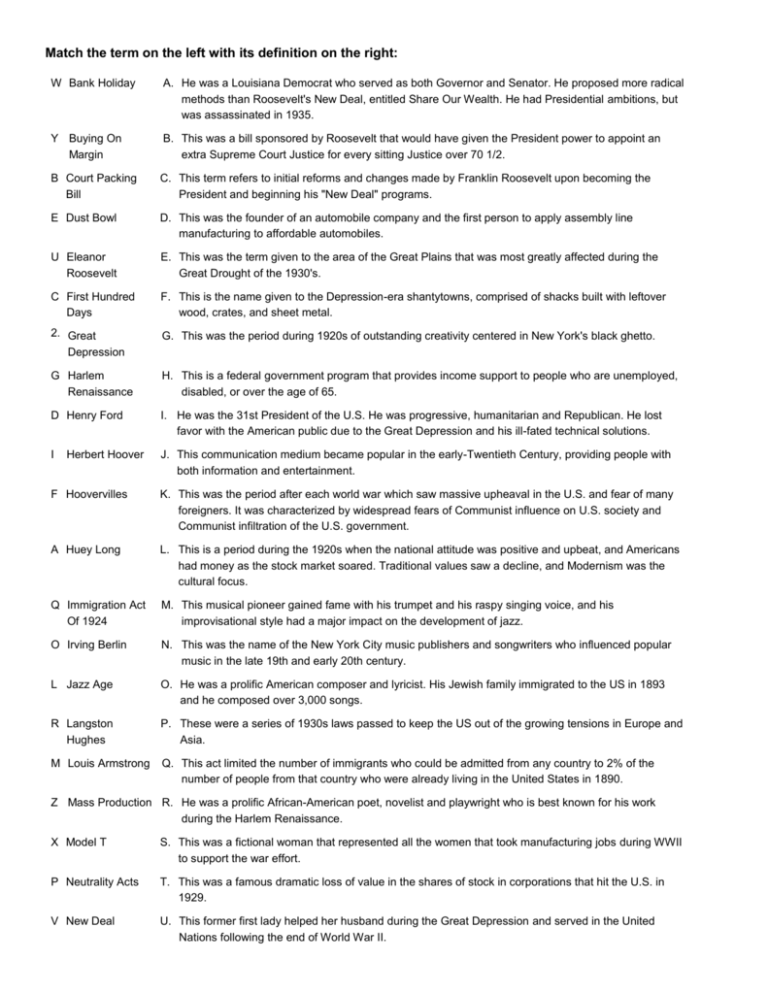
Match the term on the left with its definition on the right: W Bank Holiday A. He was a Louisiana Democrat who served as both Governor and Senator. He proposed more radical methods than Roosevelt's New Deal, entitled Share Our Wealth. He had Presidential ambitions, but was assassinated in 1935. Y Buying On Margin B. This was a bill sponsored by Roosevelt that would have given the President power to appoint an extra Supreme Court Justice for every sitting Justice over 70 1/2. B Court Packing Bill C. This term refers to initial reforms and changes made by Franklin Roosevelt upon becoming the President and beginning his "New Deal" programs. E Dust Bowl D. This was the founder of an automobile company and the first person to apply assembly line manufacturing to affordable automobiles. U Eleanor Roosevelt E. This was the term given to the area of the Great Plains that was most greatly affected during the Great Drought of the 1930's. C First Hundred Days F. This is the name given to the Depression-era shantytowns, comprised of shacks built with leftover wood, crates, and sheet metal. 2. Great Depression G. This was the period during 1920s of outstanding creativity centered in New York's black ghetto. G Harlem Renaissance H. This is a federal government program that provides income support to people who are unemployed, disabled, or over the age of 65. D Henry Ford I. He was the 31st President of the U.S. He was progressive, humanitarian and Republican. He lost favor with the American public due to the Great Depression and his ill-fated technical solutions. I J. This communication medium became popular in the early-Twentieth Century, providing people with both information and entertainment. Herbert Hoover F Hoovervilles K. This was the period after each world war which saw massive upheaval in the U.S. and fear of many foreigners. It was characterized by widespread fears of Communist influence on U.S. society and Communist infiltration of the U.S. government. A Huey Long L. This is a period during the 1920s when the national attitude was positive and upbeat, and Americans had money as the stock market soared. Traditional values saw a decline, and Modernism was the cultural focus. Q Immigration Act Of 1924 M. This musical pioneer gained fame with his trumpet and his raspy singing voice, and his improvisational style had a major impact on the development of jazz. O Irving Berlin N. This was the name of the New York City music publishers and songwriters who influenced popular music in the late 19th and early 20th century. L Jazz Age O. He was a prolific American composer and lyricist. His Jewish family immigrated to the US in 1893 and he composed over 3,000 songs. R Langston Hughes P. These were a series of 1930s laws passed to keep the US out of the growing tensions in Europe and Asia. M Louis Armstrong Q. This act limited the number of immigrants who could be admitted from any country to 2% of the number of people from that country who were already living in the United States in 1890. Z Mass Production R. He was a prolific African-American poet, novelist and playwright who is best known for his work during the Harlem Renaissance. X Model T S. This was a fictional woman that represented all the women that took manufacturing jobs during WWII to support the war effort. P Neutrality Acts T. This was a famous dramatic loss of value in the shares of stock in corporations that hit the U.S. in 1929. V New Deal U. This former first lady helped her husband during the Great Depression and served in the United Nations following the end of World War II. J Radio V. These were the programs and policies to promote economic recovery and social reform introduced during the 1930's by President Franklin D. Roosevelt. K Red Scare W. This is a term used for emergency bank closures mandated by Congress to relieve financial crises. 3. Roosevelt's Three Rs X. This was one of the earliest and most popular automobiles in the United States, manufactured by Ford Motor Company from 1908 to 1927. S Rosie The Riveter Y. This term refers to the practice of buying stocks or securities with cash borrowed from a stock broker, in the hopes of paying back the borrowed money with profits from the purchased stocks. 1. Sacco And Vanzetti Case Z. The use of the "assembly line" was key to this new method of production that was popularized by the Ford Motor Company in the early 1900's. H Social Security 1. This is the name given to the 1920 murder trial involving two Italian immigrants, the outcome of which was likely influenced by the First Red Scare. T Stock Market Crash 2. This was a period of global economic crisis that lasted from 1929 to 1939. There was widespread poverty and high unemployment. N Tin Pan Alley 3. This term describes the 3 goals of FDR's New Deal programs: relief, recovery, and reform.




